This story was originally published by CalMatters. Sign up for their newsletters.
By Christina Chkarboul and Jada Portillo, CalMatters
November 20, 2023, Updated December 11, 2023
Summary
As electric bikes and scooters gain popularity among college students, California campuses vary over their regulation. The devices pose safety risks yet are cheaper, more convenient and better for the environment than gas-powered vehicles.
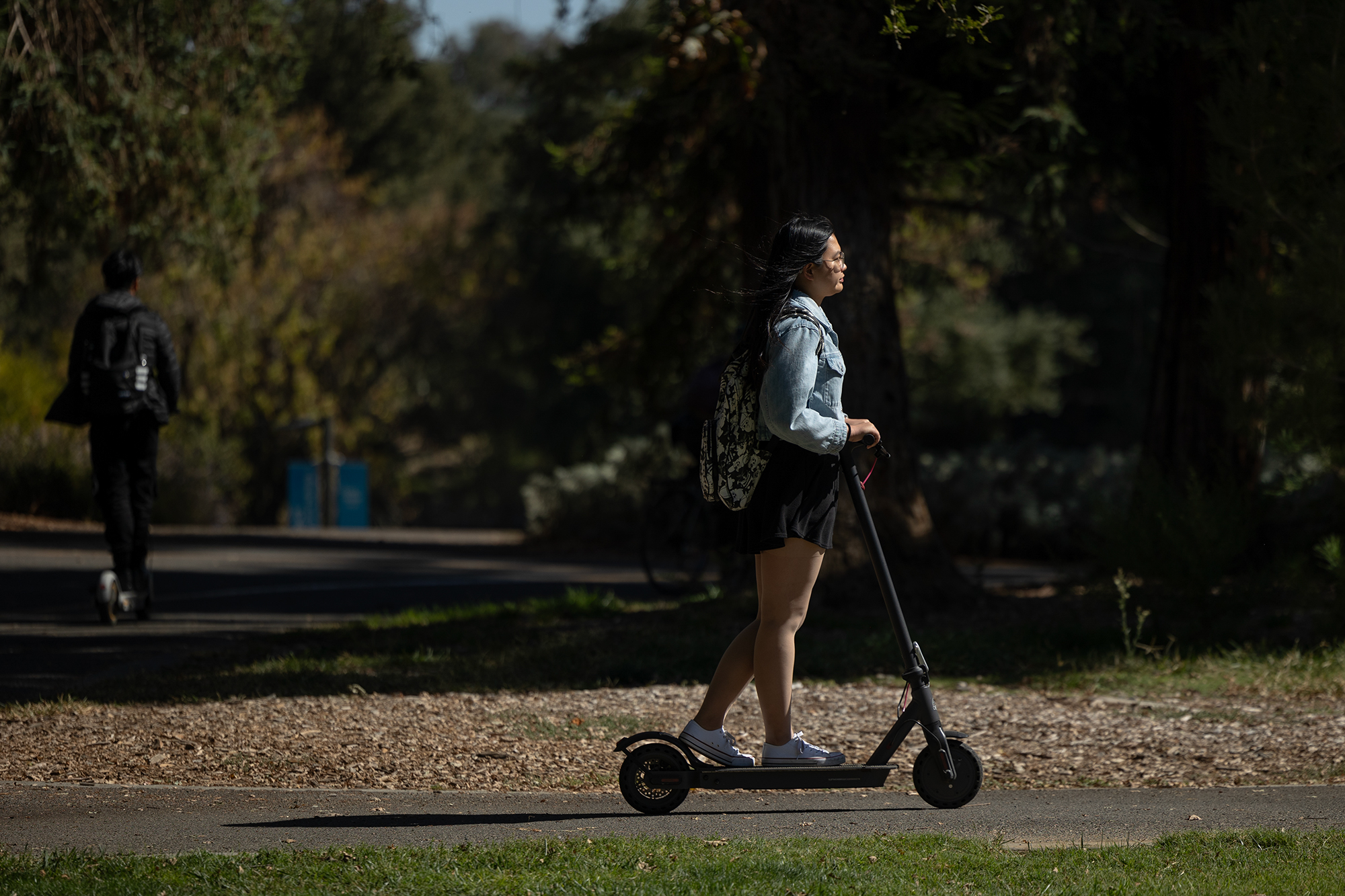
Electric bikes and scooters can be spotted in most major cities in the United States, zooming past their non-motorized counterparts and pedestrians. Despite the devices’ rising popularity, colleges across California can’t come to a consensus on just what to do about them.
Some campuses allow students to ride both e-bikes and e-scooters, while others only allow one or restrict them to certain zones. Several ban them completely.
For college students, these modes of transportation mean shorter commute times compared to walking. They’re far cheaper to rent or buy than vehicles, and easier to park, too. Since they run on electric-powered batteries, the devices are also more sustainable than gas-powered cars and produce fewer harmful emissions.
Riding an e-scooter allows Kristine Bhan, a fourth-year Cal State Long Beach student majoring in studio art, to haul heavy art supplies up the campus’ many hills.
“I hang my art supplies in a folder and the folder has a little hook, so I could hook it onto my scooter and I just ride it to upper campus,” said Bhan, who also prefers her e-scooter over her car during peak traffic.
E-bikes and e-scooters aren’t just booming on and near college campuses: Motorized micro-mobility is gaining traction across the country.
Shared e-bike trips, which are bikes that can be borrowed or rented from automated stations, or docking stations, rose from 9.5 million in 2018 to 17 million in 2021, according to a report from the National Association of City Transportation Officials.
While the devices are attractive in their speed and convenience, they also pose safety risks. They can travel more than 30 mph, meaning accidents can be severe if the rider isn’t wearing protective gear. Pedestrians are also at risk of being struck.
At UC Davis, nearly a quarter of students (22%) who rode an e-bike had an on-campus fall that resulted in an emergency room or hospital visit, according to a campus-wide travel survey conducted in 2022. Among students who rode a regular bicycle, that number was just 7.5%. Nearly 90% of e-scooter riders who fell or crashed reported an injury that didn’t need medical attention.
The devices pose another safety concern: Their lithium-ion batteries have caught fire in some cases.
Weighing the devices’ benefits and drawbacks, California’s public universities are split on whether e-bikes and e-scooters should roam campus. All 10 UCs allow e-bikes while only five UCs allow e-scooters. In the 23-campus CSU system, 10 campuses allow both e-bikes and e-scooters, while of the 116 community colleges in the state, at least 40 allow both devices. Some of those campuses restrict them to certain routes or zones.
Regulating motorized micro-mobility
Micro-mobility refers to all transportation devices smaller than a car — including bikes, scooters, skateboards, unicycles and tricycles. E-bikes and e-scooters are electric-powered with motors of up to 750 watts. The devices typically cost between $150 and $3,000.
The vehicle code allows state colleges and universities to regulate the use of bicycles, e-bikes, skateboards, electric skateboards, roller skates and “electrically motorized boards,” but does not specifically include all scooters and e-scooters. For this reason, some campuses, such as Sacramento State, allow e-scooters because campus officials don’t believe the state gives them the power to deny their use on campus.
“We actually don’t have authority, as the state of California, to tell an electric scooter operator where they can and cannot go,” said Sacramento State Director of Transportation and Parking Services Jeff Dierking.
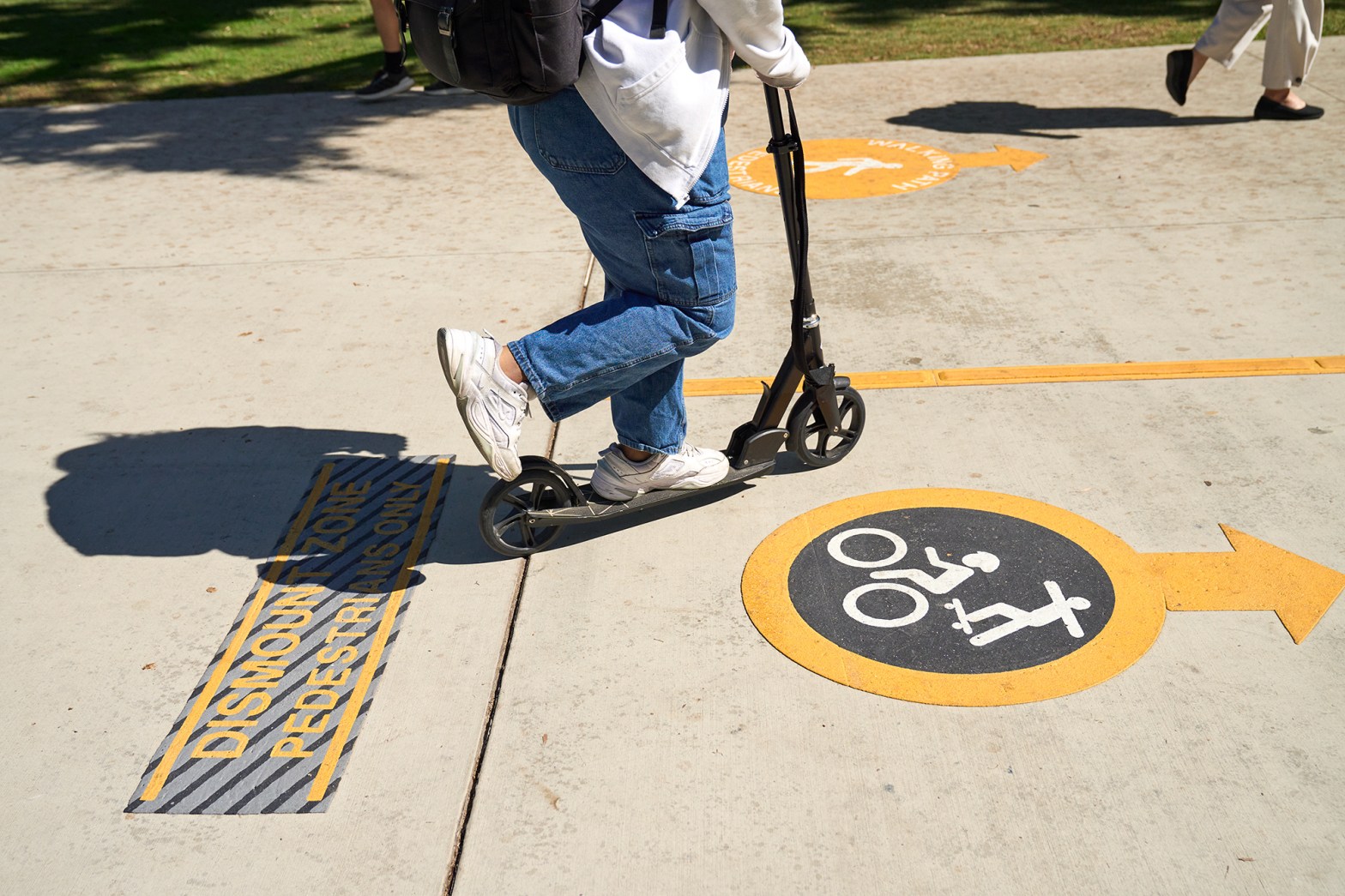
Senate Bill 295, introduced in February by state Sen. Bill Dodd, a Napa Democrat, would add e-scooters to the vehicle code. The UC Office of the President approached Dodd after several student accidents led the UC to review the code.
“College campuses have long been home to multimodal transportation, and they should pursue safety through effective education, engineering and enforcement,” Dodd said in a statement to CalMatters. “I’m standing by to help to the extent any clarification in law or other support is needed.”
The bill is pending further evaluation by the Assembly Transportation Committee.
Convenience vs. safety
It’s not hard to see why e-bikes and e-scooters are trending among students: they’re fast, fairly light and can be parked at bike racks.
After trying out her friend’s e-scooter, Anjali Patel, a senior majoring in journalism at USC, bought one of her own last year. USC allows e-bikes and e-scooters on most of its campus but prohibits the parking of rented scooters, which would cause congestion, said USC Department of Public Safety Assistant Chief David Carlisle.
Riding an e-scooter shortens Patel’s commute from her off-campus apartment from a 15-minute walk to less than 10 minutes, which means a lot, she said, when she’s running late for class or during a Southern California heat wave.
“It’s the fastest option. It’s not the most unsafe option,” Patel said. “For me, it’s the best.”
Since some motorized micro-mobility devices can reach speeds of up to 30 or even 40 miles an hour, and users often ride unprotected without helmets and other safeguards, rider safety is a concern. An October 2022 report from the U.S. Consumer Product Safety Commission found that micro-mobility injuries rose 127% from 2017 to 2021, with e-scooter trips resulting in the most rider deaths. Last year, the California Statewide Integrated Traffic Records System recorded 225 crashes involving an e-bike, up from 80 crashes in 2021.
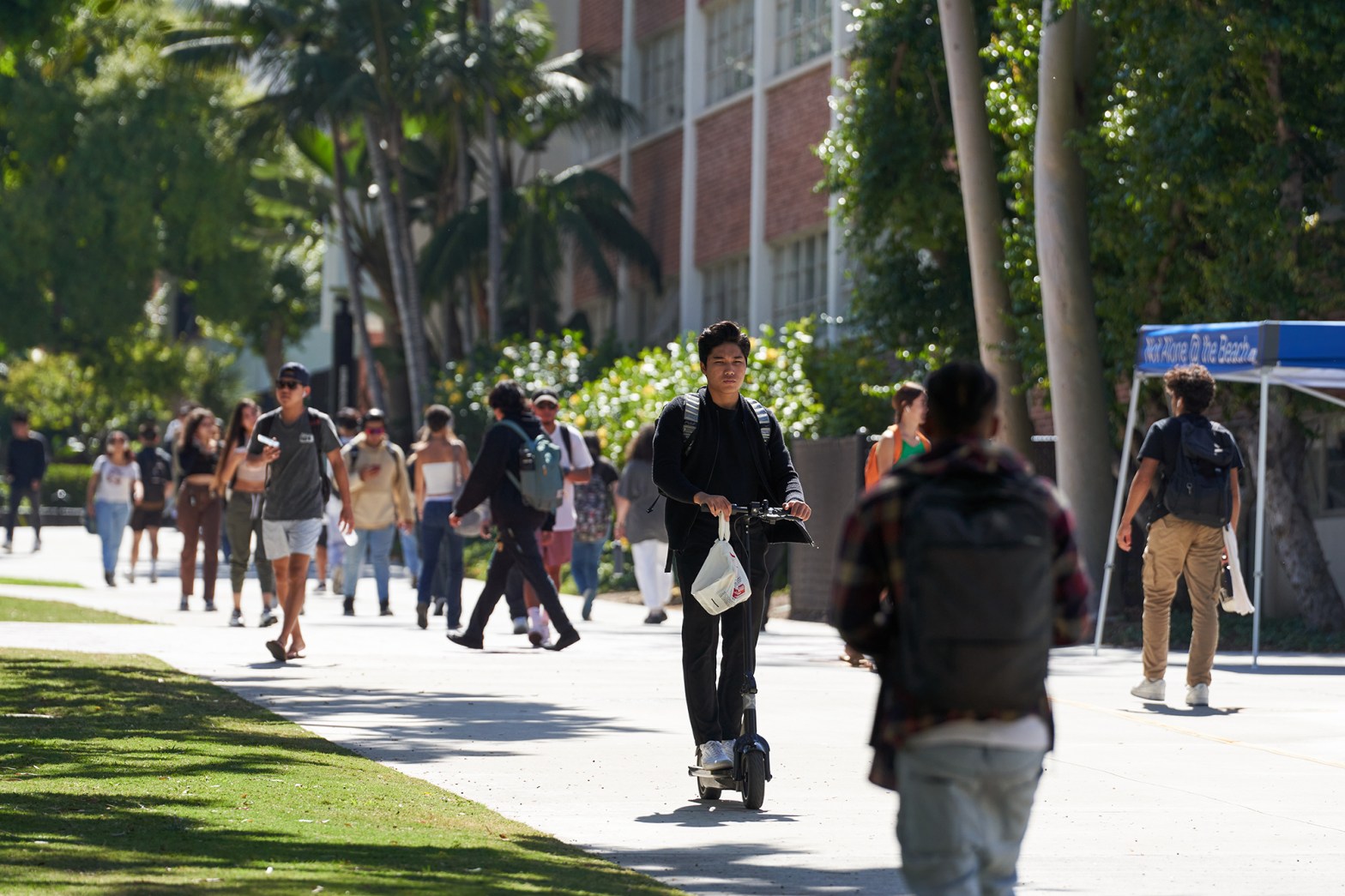
“[E-scooters] are very vulnerable to irregularities in the roadway and can toss a rider off easily if they’re going too fast,” USC’s Carlisle said.
Though Patel admits to going a little faster than she should on her e-scooter — 18 mph at most — she said she’s attentive. When others aren’t, safety becomes an issue.
“People are like, ‘Scooters and bikers are so rude and so unsafe, and they’re going so fast,’” Patel said. “I can’t use my phone while I’m scootering — my eyes are up. If anything, it’s the people walking that are not looking.”
Although she considers herself a safe driver, Patel was injured while riding her e-scooter in December. As she crossed a small intersection near her off-campus house, an idling car began moving — to Patel’s surprise — and hit her.
Luckily, the fall wasn’t too bad and, amid finals week, Patel nursed a scraped chin. The accident hasn’t led her to change the way she rides. She’s always been careful on roads and when riding around pedestrians, Patel said, though she doesn’t wear a helmet.
But some schools have seen serious student injuries — and even fatalities — from motorized micro-mobility accidents.
“[E-scooters] are very vulnerable to irregularities in the roadway and can toss a rider off easily if they’re going too fast.”
— David Carlisle, USC Department of Public Safety Assistant Chief
Even with safety rules in place, some campuses still see serious crashes and injuries. A freshman died from falling off his e-skateboard near Cal Poly San Luis Obispo in 2020, even though the campus has prohibited e-scooters, scooters and skateboards for over 10 years. The campus does allow e-bikes and bicycles.
UC Irvine bans e-scooters from the campus’ inner core, which consists primarily of pedestrian walkways. Bikes, e-bikes and non-motorized scooters, however, are allowed on a road that circles the school’s central park.
Erika Rule, UC Irvine’s sustainable programs manager, said excluding e-scooters, which are commonly ridden on sidewalks, is a matter of “protecting pedestrian safety.”
“I can’t use my phone while I’m scootering — my eyes are up.
If anything, it’s the people walking that are not looking.”
— Anjali Patel, journalism major at USC
The motorized devices come with another safety concern: the chance of starting a fire. Improperly charging e-bikes and e-scooters and using damaged chargers can overload electrical circuits, according to the National Fire Protection Association.
In March and April, Berkeley’s fire department responded to six fires related to mobility devices, including one inside a UC Berkeley dormitory. A charging e-skateboard plugged into a power strip caused an accidental fire in March at Ida Sproul Hall, resulting in damage to the room. The school’s principal mobility planner, David Sorrell, said that despite a campus-wide rule against doing so, students often ride inside buildings and charge their devices indoors.
UC Berkeley currently prohibits rented e-scooters from entering campus, but personal devices are allowed in campus bike lanes.
Disseminating information about safe riding practices has been difficult, Sorrell said, given UC Berkeley’s large student and employee populations. That’s why some at the university are eyeing a ban on micro-mobility in their areas of campus. But Sorrell has pushed back.
“The scooters are a necessity. E-bikes are a necessity,” Sorrell said, adding that high-grade hills on campus make motorized devices the easiest way to get around. “Why would we discriminate against those vehicles?”
Some campuses have struck a balance
Managing congestion, traffic flow, parking availability and student safety is a tall task for colleges deciding on micro-mobility policies.
Laney College in Oakland allows e-scooters on campus, while e-bikes have to be dropped off in designated zones on campus, Public Information Officer Mark Johnson wrote in an email to CalMatters.
Sacramento State redesigned its policy on e-bikes and e-scooters in 2019 and allows personal devices on campus with designated pedestrian-only zones, where campus police watch for violators and ask them to dismount their devices. Storage locations — bike racks and a bike compound — border the zones. A geofence around the campus perimeter deactivates all rented e-scooters and e-bikes.
“Those are high-traffic areas, and those are intended so that we can have a safe environment on campus to facilitate all equitable modes of transportation,” said Dierking of Sac State.
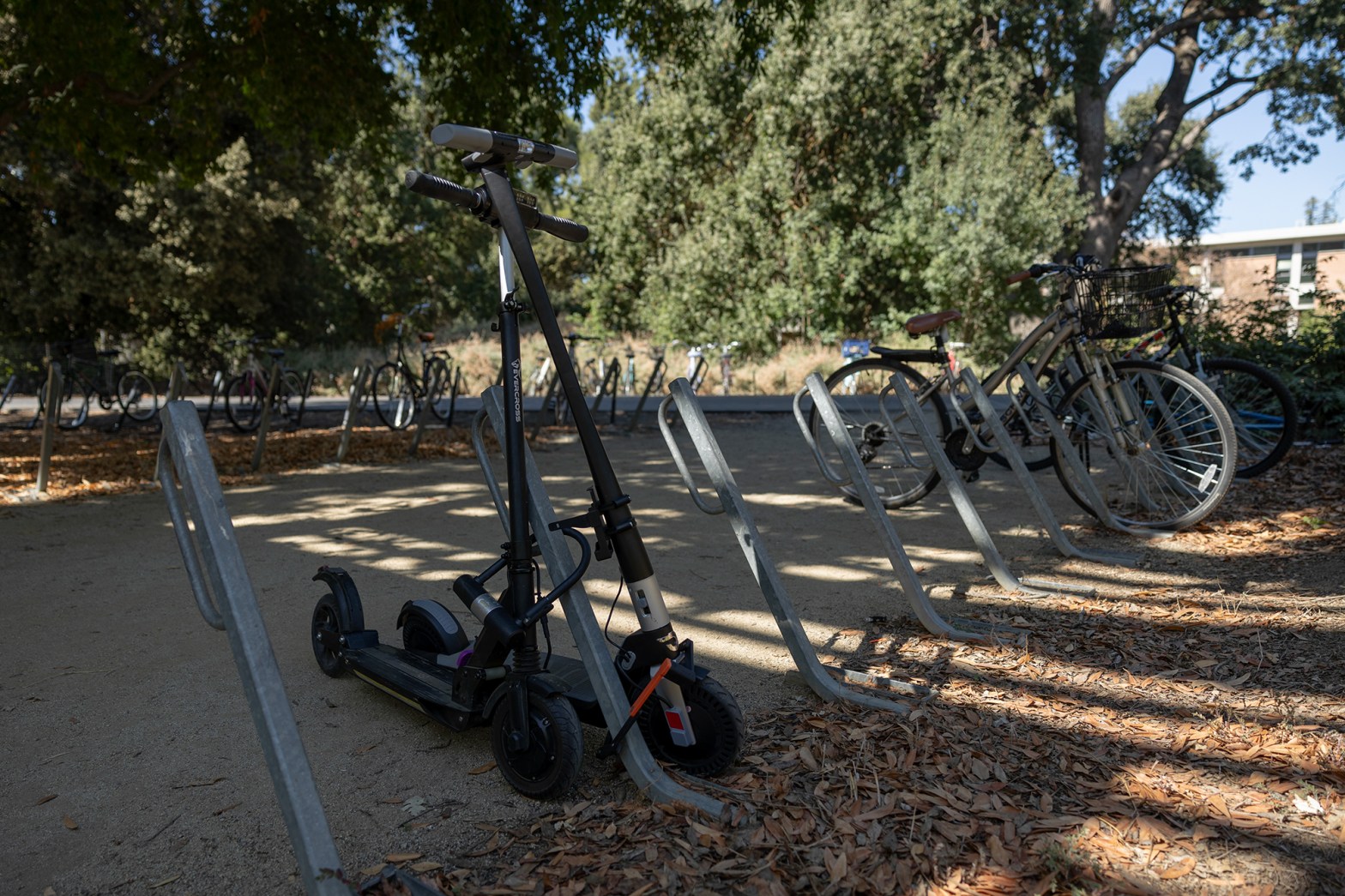
Safety concerns arise, Dierking said, when pedestrian-only zones converge with areas allowing wheeled devices. At the start of each school term, the university deploys workers wearing yellow vests to chat about safety with students on mobility devices. It also puts up signage telling road users to slow down at these intersections.
At UC Davis, a fatal student accident involving a non-electric bicycle in May 2022 led university officials to evaluate all micro-mobility policies and safeguards. The university formed working groups and conducted a campus-wide survey about safety and theft.
The working groups heard that motorized micro-mobility devices go too fast and that bikes are often stolen, said Active Modality Manager Jeff Bruchez, who heads the school’s bicycle program. According to the same study, 12% of UC Davis students who rode a bike to school in 2021-22 reported having their bike stolen.
To limit speed and theft, UC Davis introduced a shared e-bike and e-scooter program. UC Davis and the City of Davis launched a partnership with Spin on Sept. 8, making 400 e-bikes and 200 e-scooters available to students while eliminating personal liability for theft and allowing the university to regulate the devices’ maximum speeds, Bruchez said.
“By bringing a shared system onto campus, we can ensure that everyone can operate a device that fits within the ecosystem that we have, specifically that 15-miles-an-hour speed limit,” he said.
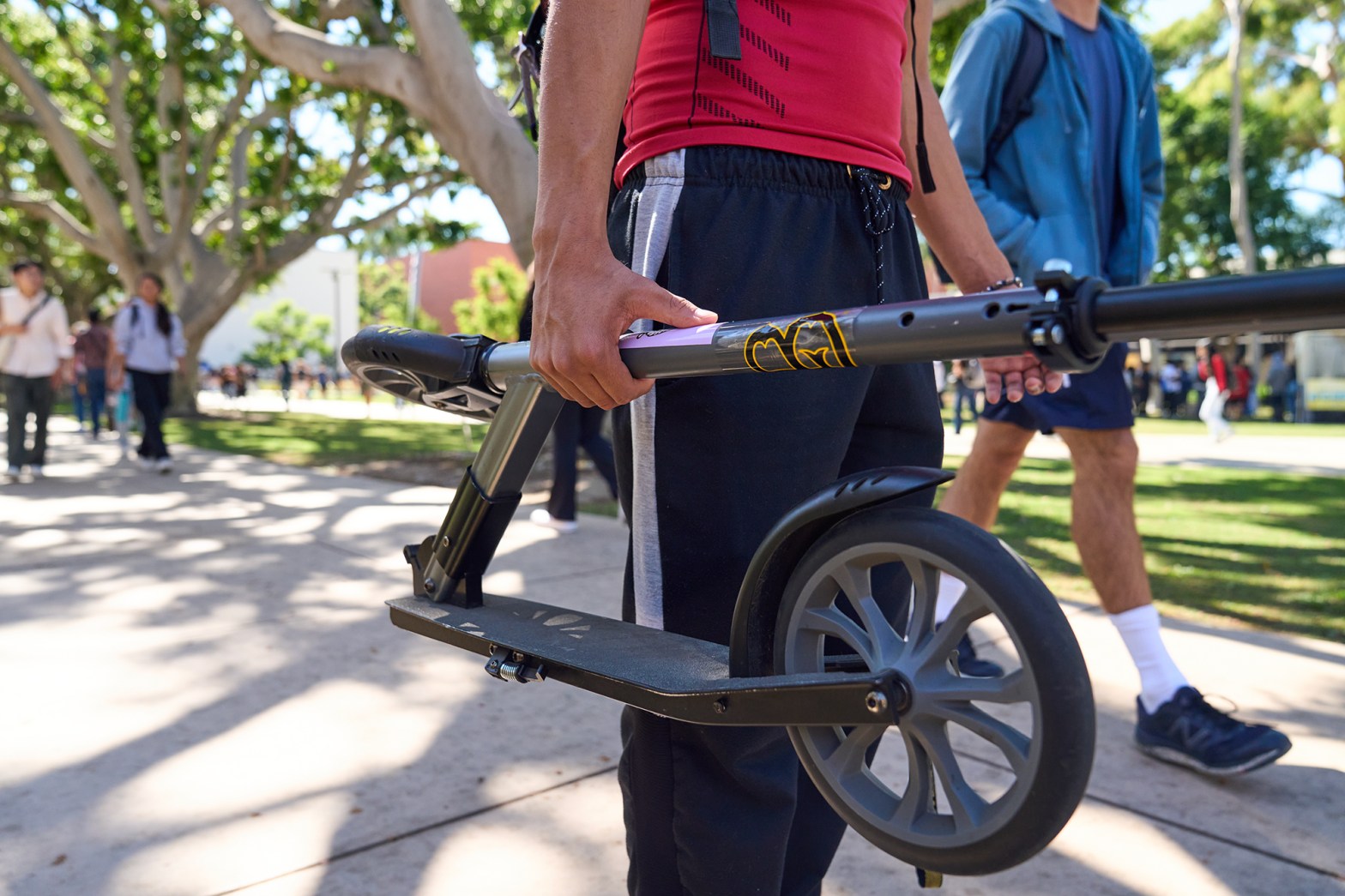
The university is hoping that revving up public education programs — including its “Helmet Hair Don’t Care” campaign that rewards students with free helmets after the completion of an eight-minute online safety course — will help reduce the number of severe collisions involving micro-mobility devices.
Across the UC system, another initiative is underway to incentivize e-bike use.
In December, an agreement UC reached with the United Auto Workers union, which represents postdoctoral workers and academic researchers, gives employees access to an e-bike discount program starting with the fall 2023 term.
The program has “made it possible” for UC San Diego sociology master’s student Beatrice Waterhouse to consider buying an e-bike. Climate demands were a key part of bargaining, she said, so the devices’ low environmental impact interested them.
“We care about the environment and we care about our universities being part of change, trying to fight for a more climate-just California and world,” Waterhouse said.
For the record: This story was updated on Dec. 11, 2023 to clarify that rules remained the same at Cal Poly San Luis Obispo after a fatal e-skateboard accident near campus in 2020.





